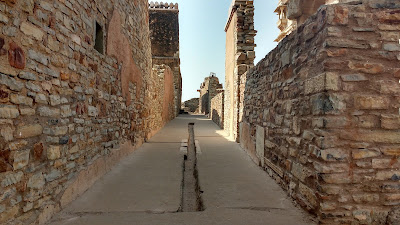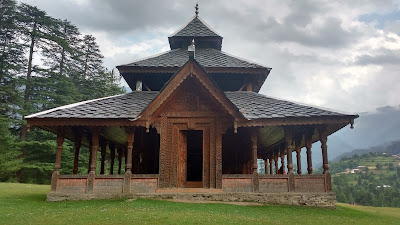World Heritage Sites
World Heritage Sites
"A World Heritage Site is a landmark which has been officially recognized by the United Nations, specifically by UNESCO. Sites are selected on the basis of having cultural, historical, scientific or some other form of significance, and they are legally protected by international treaties. UNESCO regards these sites as being important to the collective interests of humanity."
India has a total of 35 World Heritage Sites (as of 2016). I've visited a few of these till date. Use this page to link you to the site of your interest. The sites are listed by the order they have been selected in the UNESCO list. The description in italics are from the wiki citation. Click on images to read about the site. Happy reading!
-x-x-x-
#10: Group Of Monuments At Pattadakal
"The group of monuments in Pattadakal designated under UNESCO World Heritage List, in 1987, cover a remarkable series of nine Hindu temples, as well as a Jain sanctuary in northern Karnataka."
-x-x-x-
#11: Buddhist Monuments at Sanchi, Madhya Pradesh
"Buddhist Monuments at Sanchi, located 45 kilometres (28 mi) from Bhopal in the Indian state of Madhya Pradesh are a group of Buddhist monuments dated between 200 BC and 100 BC. The site, however, has been conjectured to have been developed in the 3rd century BC, when Emperor Ashoka of the Mauryan Empire ruled. The principal monument is Stupa 1 dated to the 2nd century and 1st century BC."
-x-x-x-
#12: Rock Shelters Of Bhimbetka, Madhya Pradesh
Rock Shelters of Bhimbetka - the site complex … a magnificent repository of rock paintings within natural rock shelters - is located in the foothills of the Vindhya range of hills. It is spread in sandstone formations extending over an area of 1893 ha with a buffer zone 10,280 hectares (25,400 acres). The rock shelters, discovered only in 1957, comprise a group of "five clusters of rock shelters" with paintings that are inferred to date from the "Mesolithic period right through to the Historical period", with the 21 villages surrounding them reflecting the traditions displayed in the rock paintings.
#30: Hill Forts Of Rajasthan
"Hill Forts of Rajasthan, are a series of sites located on rocky outcrops of the Aravallis mountain range in Rajasthan. They represent a typology of Rajput military hill architecture, a style characterized by its mountain peak settings, utilizing the defensive properties of the terrain. These hill forts in Rajasthan represent Rajput military strongholds across a vast range of geographical and cultural zones. It represents number of hill forts and is said to express the development of Rajput defensive architecture."
This listing has six sub-sections, out of which I've covered two till date:
-x-x-x-
#31: Rani Ki Vav Of Patan
"Rani Ki Vav (The Queen's Step-well) at Patan, Gujarat, is a famous step-well. It is famous for its size and sculpture."
Kind of an understated description for a grand monument. :D
-x-x-x-
#32: Great Himalayan National Park
"Great Himalayan National Park at Kullu, Himachal Pradesh, is characterized by high alpine peaks, alpine meadows and riverine forests. The 90,540 ha property includes the upper mountain glacial and snow melt water source origins of several rivers, and the catchments of water supplies that are vital to millions of downstream users. The GHNPCA protects the monsoon-affected forests and alpine meadows of the Himalayan front ranges. It is part of the Himalaya biodiversity hotspot and includes 25 forest types along with a rich assemblage of fauna species, several of which are threatened. This gives the site outstanding significance for biodiversity conservation."
My excursion into the GHNP has been limited to a visit to the village of Shangarh within the eco-zone. The village is picture-perfect!
-x-x-x-
Hope to add a few more soon!
© One Of The Road
"A World Heritage Site is a landmark which has been officially recognized by the United Nations, specifically by UNESCO. Sites are selected on the basis of having cultural, historical, scientific or some other form of significance, and they are legally protected by international treaties. UNESCO regards these sites as being important to the collective interests of humanity."
India has a total of 35 World Heritage Sites (as of 2016). I've visited a few of these till date. Use this page to link you to the site of your interest. The sites are listed by the order they have been selected in the UNESCO list. The description in italics are from the wiki citation. Click on images to read about the site. Happy reading!
-x-x-x-
#10: Group Of Monuments At Pattadakal
"The group of monuments in Pattadakal designated under UNESCO World Heritage List, in 1987, cover a remarkable series of nine Hindu temples, as well as a Jain sanctuary in northern Karnataka."
-x-x-x-
#11: Buddhist Monuments at Sanchi, Madhya Pradesh
"Buddhist Monuments at Sanchi, located 45 kilometres (28 mi) from Bhopal in the Indian state of Madhya Pradesh are a group of Buddhist monuments dated between 200 BC and 100 BC. The site, however, has been conjectured to have been developed in the 3rd century BC, when Emperor Ashoka of the Mauryan Empire ruled. The principal monument is Stupa 1 dated to the 2nd century and 1st century BC."
#12: Rock Shelters Of Bhimbetka, Madhya Pradesh
Rock Shelters of Bhimbetka - the site complex … a magnificent repository of rock paintings within natural rock shelters - is located in the foothills of the Vindhya range of hills. It is spread in sandstone formations extending over an area of 1893 ha with a buffer zone 10,280 hectares (25,400 acres). The rock shelters, discovered only in 1957, comprise a group of "five clusters of rock shelters" with paintings that are inferred to date from the "Mesolithic period right through to the Historical period", with the 21 villages surrounding them reflecting the traditions displayed in the rock paintings.
-x-x-x-
#30: Hill Forts Of Rajasthan
"Hill Forts of Rajasthan, are a series of sites located on rocky outcrops of the Aravallis mountain range in Rajasthan. They represent a typology of Rajput military hill architecture, a style characterized by its mountain peak settings, utilizing the defensive properties of the terrain. These hill forts in Rajasthan represent Rajput military strongholds across a vast range of geographical and cultural zones. It represents number of hill forts and is said to express the development of Rajput defensive architecture."
This listing has six sub-sections, out of which I've covered two till date:
-x-x-x-
#31: Rani Ki Vav Of Patan
"Rani Ki Vav (The Queen's Step-well) at Patan, Gujarat, is a famous step-well. It is famous for its size and sculpture."
Kind of an understated description for a grand monument. :D
-x-x-x-
#32: Great Himalayan National Park
"Great Himalayan National Park at Kullu, Himachal Pradesh, is characterized by high alpine peaks, alpine meadows and riverine forests. The 90,540 ha property includes the upper mountain glacial and snow melt water source origins of several rivers, and the catchments of water supplies that are vital to millions of downstream users. The GHNPCA protects the monsoon-affected forests and alpine meadows of the Himalayan front ranges. It is part of the Himalaya biodiversity hotspot and includes 25 forest types along with a rich assemblage of fauna species, several of which are threatened. This gives the site outstanding significance for biodiversity conservation."
My excursion into the GHNP has been limited to a visit to the village of Shangarh within the eco-zone. The village is picture-perfect!
-x-x-x-
Hope to add a few more soon!
© One Of The Road







Comments
Post a Comment